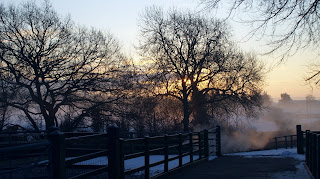Number 1 in an occasional series on the Art of Muck Heap Management
When I first took up riding in the early 1990s I was told by an old hand that she always judged an equestrian establishment by the state of its muck heap. These words have stuck with me over the years and left me with a lasting desire to present a muck heap to be proud of.
In this series of blogs I will present the art of muck heap management as it appears to self taught me. I will try to explain how you develop a muck heap to be proud of and help to protect the environment in the process.
So let’s start by considering what makes for the perfect muck heap? Well as always the clue is in the name; MUCK and HEAP. We’ll come back to muck but let’s start with heap. That’s a very important word. It’s a muck HEAP, not a muck SPREAD! Heap implies height; spread implies somebody can’t be assed to fork it up.
Muck is either droppings, horse or sheep and the wetter the better, or soiled bedding. In other words the bit they’ve peed on. Wet is important because if you put pristine bedding on your muck heap it’s going to take a long time to rot down.
In rotting down the muck heap produces heat; so you’ll see steam rising from the heap on a cold morning (and the occasional fox taking advantage of a warm bed). The heat can dry the heap out and stop the rotting process so I’ve always found you can’t get enough rain or snow into the mix.
On a slightly serious note it is worth remembering that pure muck is not regulated as a waste if it is treated on its own. However mix it with grass cuttings, for example, and it becomes a controlled waste according to the Environmental Permitting (EP) Regulations 2007. I hadn’t realized that until I came to research this blog. So while we’re in the regulation arena it’s also worth noting that muck that is disposed of by burning, tipping or burial is classified as a controlled waste.
The good news is that muck that is spread and used as a fertiliser to benefit land is not treated as a waste and as such, is not subject to the EP Regulations 2007. Just be careful that any runoff water is not going to find its way into a water course.
So what else should the beginner beware of with his prototype heap?
· Watch out for spontaneous combustion especially in hot, dry and windy weather
· Don’t throw stones on the muck heap otherwise they might come flying out and hit someone when you’re spreading
· The same applies to dog poo
Hopefully I have inspired you to make a start; future instalments will look at “Tools of the Trade”, “How you’ll know when it’s ready” and “ensuring biodegradation”.




Comments
Post a Comment